|
REVOLUTION & INDEPENDENCE |
|
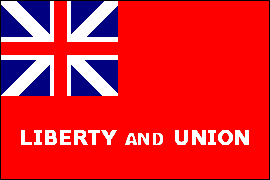
Taunton Flag • 1774 |
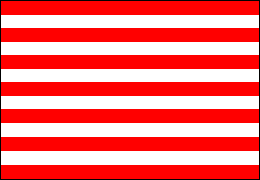
Sons of Liberty |
|
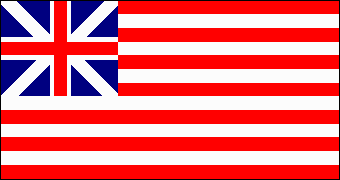
The Continental
Colors • First US National
Flag • 1776-77 |
In
the years immediately prior to the outbreak of the Revolution most
colonial flags, official and unofficial, were variants of British
flags and ensigns. Undoubtedly the most familiar was the Red Ensign,
nicknamed the Meteor Flag. As the quarrel between Britain and its
American colonies intensified, a common form of protest was the
raising of a flag over some public space, typically the village
common. This happened in Taunton, Massachusetts on October 21, 1774,
and the flag raised was a Red Ensign with the inscription LIBERTY
AND UNION in the lower half. (Whether the Taunton Flag looked
exactly as depicted above is doubtful, since all we have is a
contemporary newspaper description of the design.) Another flag of
protest was that of the Sons of Liberty: thirteen strips, red and
white, symbolizing the unity of the Thirteen Colonies in the defense
of their liberties. It has been suggested that the field of stripes
was inspired by the ensigns of the
British East India Company. No
documentary evidence exists to prove that this was so, though
certainly the
ships and flags of the Company were a familiar sight in American
waters.
The first, albeit unofficial,
national flag of the United States was the Continental Colors, also
known as the Grand Union Flag. Combining the field of stripes with
the British Union Flag, it symbolized the colonies’ continuing
loyalty to the Crown while proclaiming their unity in defense of
their liberties. This flag was hoisted as an ensign aboard the Alfred, a warship of the Continental Navy that was commissioned
at Philadelphia on 2 December, 1775. (Her captain was
Lieutenant John Paul Jones.) The story that it was raised on New
Year’s Day, 1776, over Prospect Hill near General George
Washington’s headquarters in Cambridge, Massachusetts, is generally
accepted but disputed by some historians. There is no doubt,
however, that the Continental Colors were widely employed by the
Continental Army as a garrison flag and by the Continental Navy as
an ensign, and that it thus became, in fact if not in law, the first
national flag of the United States of America following the signing
of the Declaration of Independence on the Fourth of July, 1776.
|
|
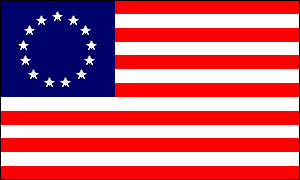 |
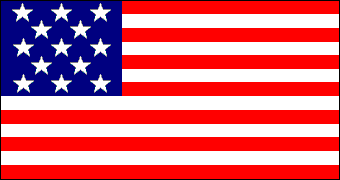 |
|
A
New Constellation • 1777-97 • 13 Stars & 13 Stripes |
|
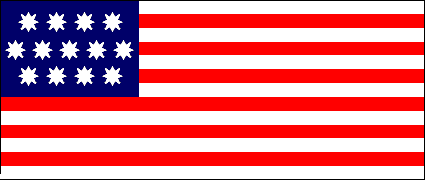
John Shaw's
Design • 1783 |
With the Declaration of Independence,
the new nation clearly required a flag of its own. Accordingly, on
14 June 1777, the Second Continental Congress passed a resolution
adopting a national flag for the United States of America:
“Resolved, That the flag of the United States be thirteen stripes,
alternate red and white; that the union be thirteen stars, white in
a blue field, representing a new Constellation.” The thirteen
stripes were brought forward from the Continental Colors and various
claims have been advanced concerning the blue “union” with its white
stars. Betsy Ross of Philadelphia is often given credit for sewing
the very first Stars & Stripes, but this claim is based on
little more
than Ross family tradition. Francis Hopkinson, a signer of the
Declaration of Independence from New Jersey, claimed credit
for the design and likely did play a role in the creation of the
Stars & Stripes.
The Flag Resolution did not specify
the new flag’s proportions, color shades or the arrangement of the
stars and the stripes. The Betsy Ross design, with seven red
stripes, six white stripes and the stars arranged in a circle,
undoubtedly did exist, but the were countless variations on the
basic theme. Flags with the stars arranged in rows, 3-2-3-2-3, were
common, as were flags with seven- or eight-pointed stars. Seven red
and six white stripes were usual, but several well-known flags of
the period, such as the Shaw flags produced for the sitting of
Congress in Annapolis, Maryland, in 1781, had seven white and six
red stripes. (See
here
for some additional Revolutionary-era variants of the Stars &
Stripes.)
|
|
THE
STAR-SPANGLED BANNER |
|
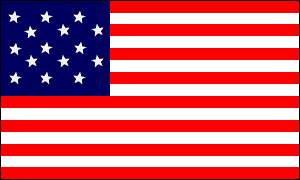
1797-1818 • 15
Stars & Fifteen Stripes |
In 1797 two stars and two stripes were added to the flag to mark the
admission to the Union of the states of Kentucky and Vermont. Thus
was created the original Star-Spangled Banner: the flag that
inspired Francis Scott Key to compose the poem that became the
lyrics of the US national anthem. The War of 1812 had been raging
for two years when a British naval squadron carrying 5,000 troops
arrived off Baltimore, Maryland, with the intention of capturing the
city. Early on the evening of September 13, the British warships
opened a bombardment of Fort McHenry, which guarded the approach to
Baltimore Harbor. Key, a Washington lawyer who had come to Baltimore
to negotiate the release of a civilian prisoner of war, watched the
bombardment from a nearby truce ship. From time to time during the
night the bursting of mortar bombs and rockets enabled him to catch
a glimpse of the fort’s large garrison flag. As dawn broke on
September 14, Key saw that “our flag was still there,” indicating
that Fort McHenry remained in American hands. That very morning Key
began to compose his poem, which he titled “Defense of Ft. McHenry.”
Later in the month the poem was struck off as a handbill with an
introduction explaining how it had come to be written and a note
advising that it was to be sung to the tune of a popular English
air, “To Anacreon in Heaven.” Soon retitled “The Star-Spangled
Banner,” Key's song became popular throughout the United States,
though it was not made the official US national anthem until 1931.
(See here for words and music.) The
actual flag that inspired Key survived and is on display in the
Smithsonian Institution.
Though five more states
were admitted to the Union between 1797 and 1817, the impracticality of adding
a stripe for each one prevented the flag from being
updated to reflect the nation's continuing growth.
|
|
THE
ERA OF MANIFEST DESTINY |
|
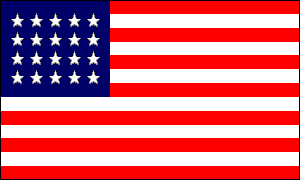
1818-19 •
20 Stars |
In
1818 an Act of Congress resolved the problem of the stripes,
specifying that the number of stars in the union of the flag would
correspond to the current number of states, while the stripes would be
reduced to thirteen, commemorating the original thirteen states. The
Act also specified that upon the admission of a new state to the
union, a star would be added to the flag on the following Fourth of
July.
|
|
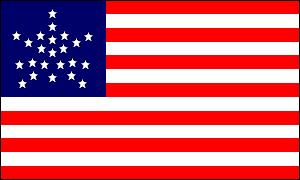
Great Star Flag •
1820-22 • 23 Stars |
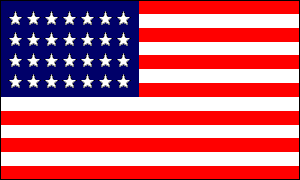
1846-47 • 28 Stars |
|
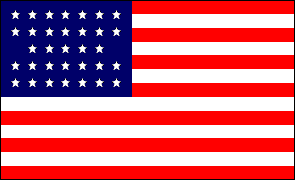
1859-61 • 33
Stars |
President Thomas Jefferson's purchase
of the Louisiana Territory from France in 1803 virtually doubled the
size of the United States. Florida was acquired from Spain in 1819,
the Oregon Territory was purchased from Britain in 1846 and the
Mexican War (1846-48) added further vast territories, including
California. Between 1818 and 1861, thirteen
more states joined the Union and there were twelve successive
versions of the flag. (In 1823 Alabama and Maine were admitted to
the Union, taking the flag from 21 to 23 stars.) The 28-star flag
of 1846 marked the admission of Texas to the Union. There was still
no overall law specifying the flag’s color shades, proportions or
arrangement of stars, though Army and Navy regulations described
standard patterns. Since 1818 naval regulations had specified
ensigns in a range of standard dimensions with five-pointed stars
arranged in rows, and seven red and six white stripes. But private
flag makers remained free to follow their fancies. One popular
nineteenth-century variant of the Stars & Stripes was
the “great star” flag, with the stars in the union arranged in the
shape of one large star. In 1859 a 33rd star was added for Oregon
and this was the national flag of the United States at the beginning
of the Civil War.
|
|
RALLY 'ROUND THE FLAG •
THE CIVIL WAR |
|
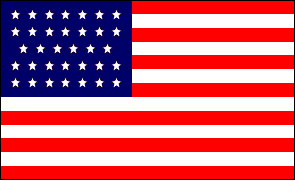
1861-63 • 34
Stars |
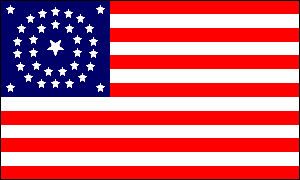
Variant • 1861-63 • 34
Stars |
|
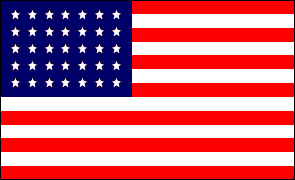
1863-65 • 35
Stars |
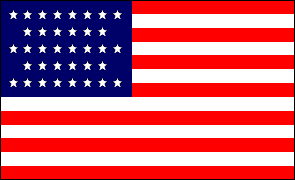
1865-67 • 36
Stars |
The Confederate bombardment of Fort Sumter (Charleston,
South Carolina) on 12 April 1861 heralded the outbreak of the Civil
War. The succession of eleven states was not recognized by the
federal government and no stars were removed from the flag. On the
contrary, a 34th star was added for Kansas on the Fourth of July
1861. In 1863 a 35th star was added for West Virginia. The
33-, 34- and 35-star flags were all used during the Civil War by the
federal and state governments, the Army and Navy, and private
citizens. Finally, on the Fourth of July 1865 a 36th star was added for
Nevada—little more than a month before President Andrew Johnson
declared a formal end to the war.
|
|
FROM SEA TO SHINING
SEA |
|
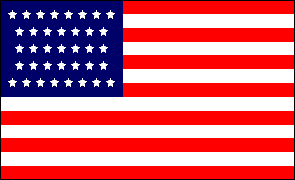
1867-77 • 37 stars |
|
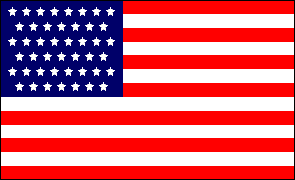
1886-1908 • 45
Stars |
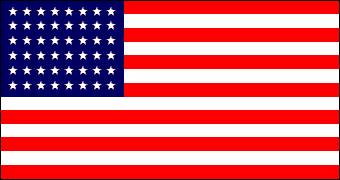
1912-59 • 48
Stars |
|
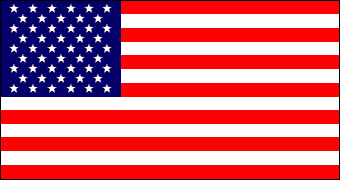
Since 1960 • 50 Stars |
The half-century following the end of the Civil War witnessed the
admission of twelve states to the Union, taking the flag from 36 to
48 stars. The 37th star was
added for
Nebraska in 1867, and this was the flag
that flew over the United States during the centennial year of
American independence, 1876. By the time of the Spanish-American War
the flag had 45 stars and in 1912 the admission of New Mexico and
Arizona completed the pattern. The 48-star flag served America for
47 years, through two world wars and the first phase of the Cold
War. In 1959 a 49th star was added for Alaska and the 50th for
Hawaii in 1960. |


















